Coconut is an essential fruit in many parts of the world, although humans are one of the few species that use them. The easiest way to grow Coconut palms is by a pot nursery plant, but you can grow them with seeds. Coconut trees that are grown in containers are short-lived. They can only survive five to six years, but although they are short-lived, growing Coconut trees are a fun project. Let’s check out how to grow Coconut from seed at home.
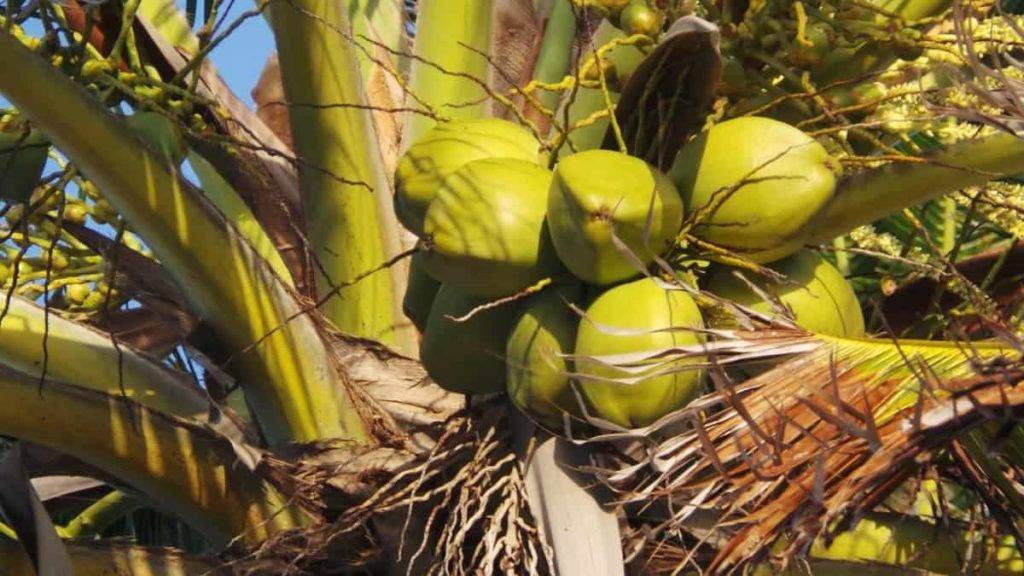
Coconut produces a fruit that contains a seed. The fruit contains an endocarp or shell that shelters the seed. When you shake the fruit and hear Coconut milk splashing inside the fruit, the Coconut seed is ready to grow and plant. Growing a Coconut plant from a shop-bought Coconut requires little information about the fruit. You should select the suitable Coconut from the store, and it takes time to sprout.
Mature brown ones are good for planting. The Coconut tree grows from a seed, a whole Coconut, takes 3 to 8 years to give fruit, and lives between 60 and 100 years. Each Coconut takes about a year to prepare, from flower to fruit. There are many ways to grow Coconut trees from seed. You can either choose Coconut with husk or straw. Both have different ways of producing Coconut saplings.
How to grow Coconut from seed at home
Different types of Coconut trees
Choosing Coconut trees correctly before seeding and planting Coconut is an essential first step. Although there are many different types of Coconut palms, they are all divided into two main categories: tall and dwarf. The most common type is the tall variety. The tall Coconut palm tree is a cross-pollinator, sharing genetic material with other trees. The result is that the fruits of this type of tree can vary significantly in character.
Coconut Coir Benefits for Gardening, Making, Uses
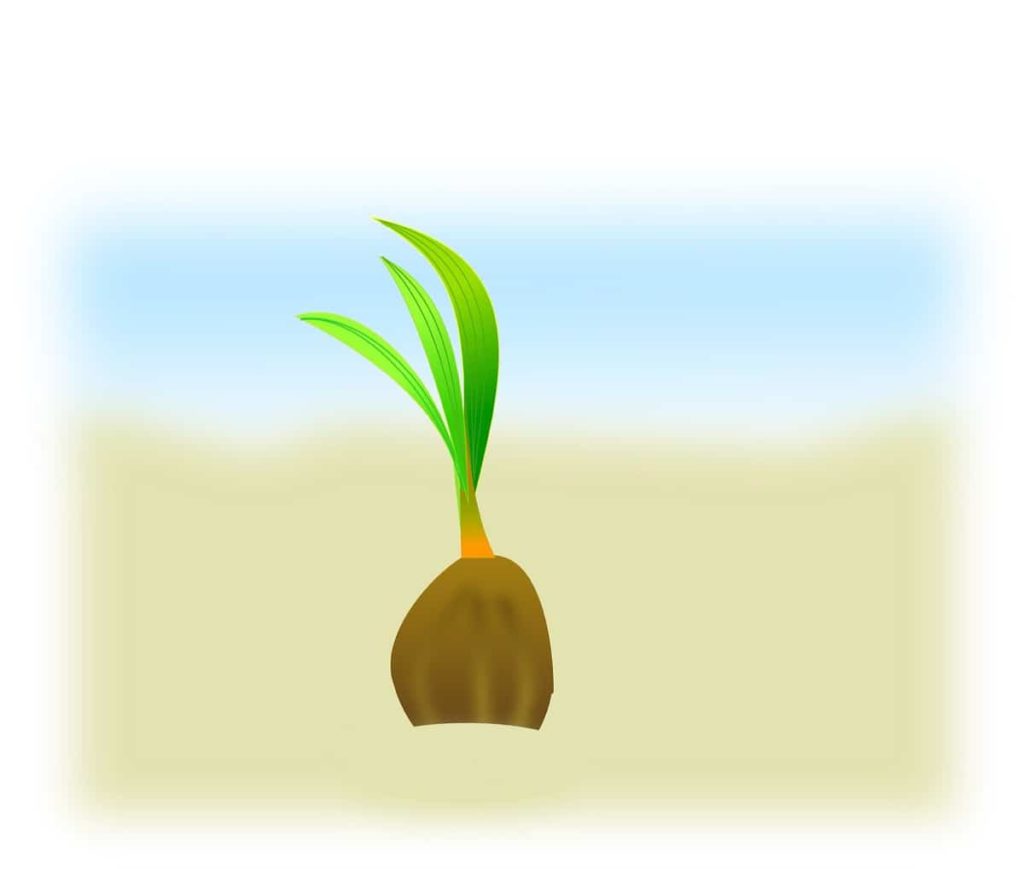
The main varieties of tall Coconut trees are niu kafa (which are wild) and niu vai (domesticated). The names only indicate where tall Coconut palms are grown, though. The dwarf Coconuts are the second most common type of this species. They are usually smaller than the tall Coconut tree. Since they are mostly self-pollinated, these types of trees are less. More resistant to disease than its tall trees, the dwarf tree is the preferred species to plant palm trees in home gardens and parks.
The dwarf palms grow up to 5 meters and usually produce fruit after three to five years. They are also considered more beautiful with orange leaves and crowns, while their Coconut fruit is gold, green, bronze, or olive.
Climate conditions required for the growing Coconut from seed
As tropical plants, Coconut palm trees prefer a hot and humid climate with an average annual temperature of about 27°C. Still, trees can be grown elsewhere unless the climate has experienced freezing temperatures. Coconut palms thrive throughout the sun, which means at least six hours of direct sunlight on most days. Even the palms found in nature can struggle in the shade, so any indoor Coconut palm must get plenty of sunlight.
Depending on its place in your home, consider the sunlight and move your plant location throughout the day to ensure proper exposure. Coconut palms require a temperature that is at least 21°C. They may fail to thrive if the temperature is below 18°C. High humidity is also an essential factor. You can also place the container on pebbles and water trays to increase moisture around the plant. Be careful; the lower part of the container is not touching the water.
Soil requirement for the growing Coconut from seed
Some people like to plant Coconut seedlings in the pot, and some on open land. When planting Coconut in a pot, you need to know what kind of Coconut you are growing. Some dwarf species grow in small spaces and do not need much space. At the same time, some grow into tall trees with large roots that can grow only in an open space. Coconut palms are used to growing in various soil conditions and therefore are not picky about their planting mixture. It says that soil that closely mimics the natural environment of the Coconut palm is always excellent.
Top Miracle Grow Tips for Your Garden Plants: Vegetables, Fruits, Flowers, and Herbs
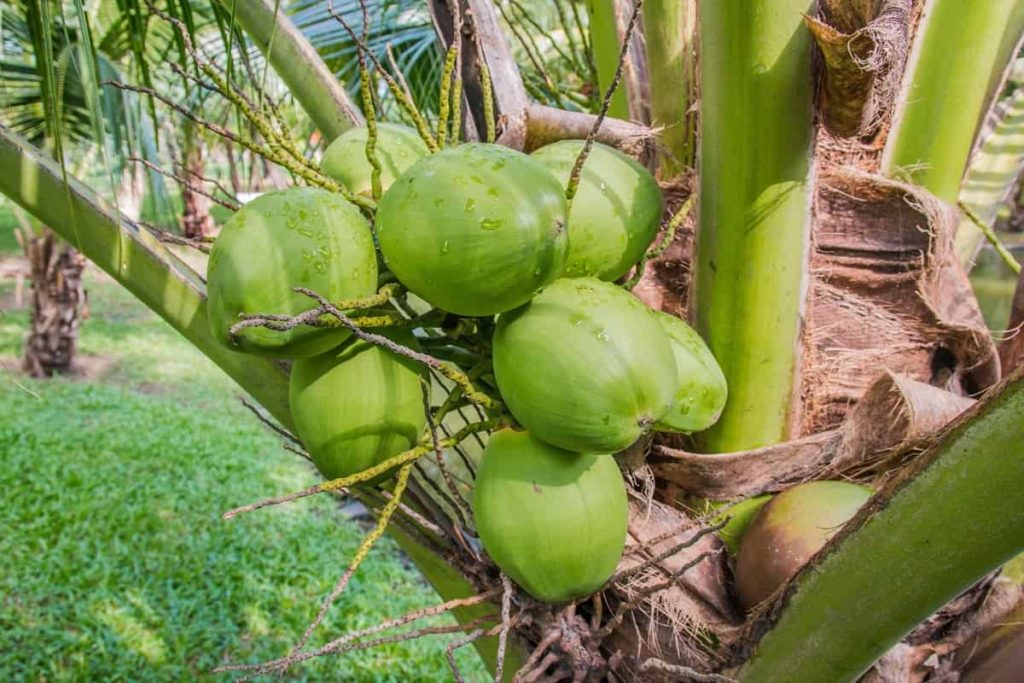
A well-draining palm clay mixture works well for potable Coconut palms. Where your soil doesn’t drain well, you’ll begin the Coconut tree planting process by amending the soil for your Coconut trees to a depth of 2 feet with a shovel. Once the hole is dug, mix equal parts peat, sand, and topsoil. It makes your soil loose and nutrient-rich, perfect for your baby Coconut trees. Conversely, these plants will die quickly if they’re in standing water or planted in soggy soil.
Coconut seed germination process
A lot of water inside the Coconut is the ideal nut that will move around when you shake it. Make sure that the nut is still in its husk. You should keep the Coconut submerged in the bucket. Leave the nut in the bucket for 3 to 4 days. This process will soften the Coconut and speed up the germination process. Keep the nut in the bag and seal it. Place the bag in a hot, dark place for three months.
Once the nut is cracked and the roots start growing, the seed will be fully ready when the sprouts are almost long up to your finger and the roots have reached 6 inches to 8 inches. If you want to plant in a pot, use half a potting soil and half a sand mixture, and add some fine gravel or vermiculite to help fuel the soil. If you plan to put your Coconut outside, you don’t have to use mixed soil in advance.
Find a place outside that has loose and well-draining soil. Place the nut in the soil with the pointed end. Be careful 1/3 of the Coconut stick to the soil. If you are planting your tree indoors, use a pot at least 10 inches deep and large enough to accommodate the seed. Water the Coconut tree at least two times a week. Make sure the tree gets a lot of light, but there is no permanent brightness. Sprinkle water on both sides of the leaves and keep the indoor trees moist.
Coconut seed grows slowly; it takes up to 4 months for a shoot to appear. During germination, the single cotyledon (seed leaf) grows within the depth of the seed. After two weeks, it becomes a little hardened and then starts to make the first root downwards, followed by a shoot on the top. It also grows a sheath to save the seedling’s roots. It grows with them through the softest of all three eyes at the base of the shell.
Guide to Growing Red Banana in Home Garden: Planting and Care
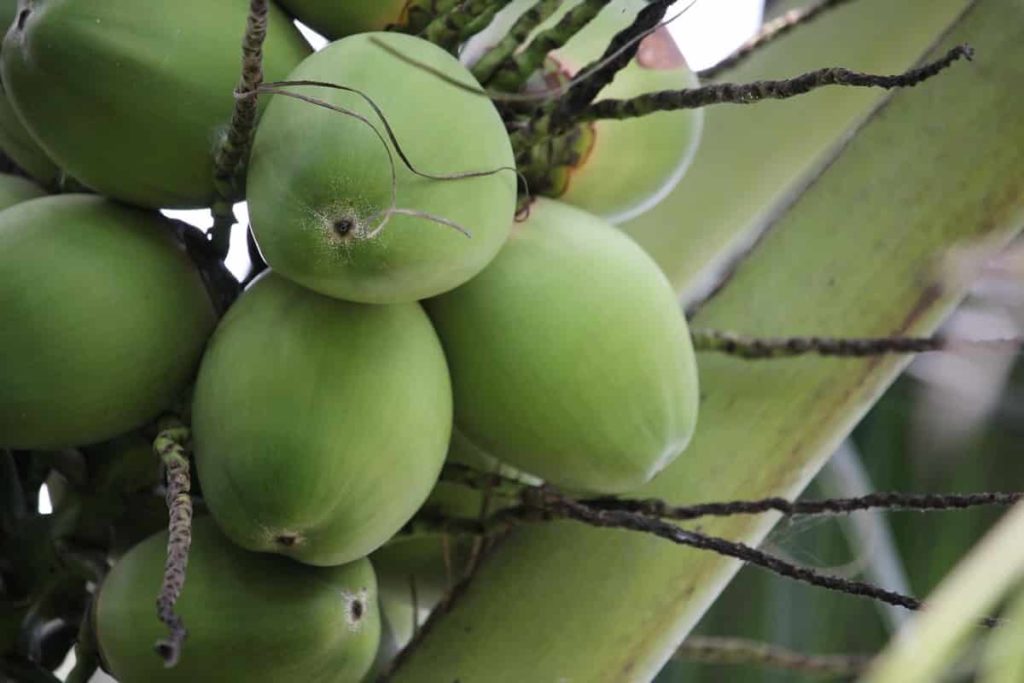
Transplanting Coconut seedlings
Preferably select a place not too close to a big tree. Big trees have large roots that take up more nutrients and water from the soil. Big trees cover a large area making it difficult for the sunlight to fall directly. After you have decided where to plant it; make a hole not less than 1.5 meters deep, make sure you fill the hole with red loamy, sandy, and well-drained soil. Natural compost is suitable for this plant that does not mean you cannot use chemical fertilizers in the right amount.
Dig a large hole that is enough to cover the 2/3rd part of your already growing Coconut seedling. Gently remove your Coconut from its first container and brush any soil. Take this time to straighten out any tangled roots. This will help further stretch roots and ensure proper development down the line. It is essential to remove your germinating Coconut from its container without damaging the roots. Plant the seedlings in-depth outside; it was planted in their container.
Do not cover your Coconut seed completely with soil. Place this seed in the hole with its roots down and backfill from the dirt. You will leave the 1/3 exposed on top of the already grown Coconut. Cover the current soil line with dirt from the germination process. Once your Coconut is planted, you should add a single layer of mulch. Organic mulches like grass clippings, dried or composted leaves, pine needles, or straw will work. You would like to stretch the mulch 3 inches deep and 8 inches from the tree stem.
Water requirement for growing Coconut from seed
Like many plants, Coconut trees also love warmth and moisture; the Coconut palm is a thirsty tree. Water your plant twice a week. The quantity of water you give may vary based on the size of the plant. If it has grown, water two to three liters of water in a new Coconut plant or five to seven liters of water. If it is the rainy season, it may not be needed twice a week.
Guide To Growing Palm Trees: Planting and Care
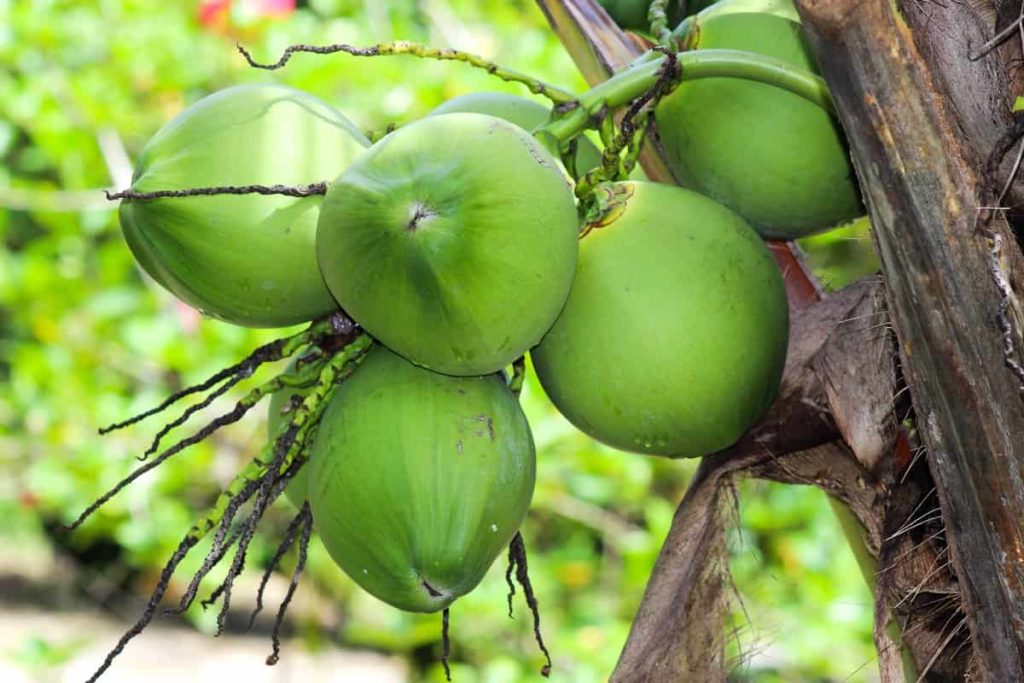
At an early stage, when Coconut is sprouting, it usually needs more water. Keep the soil moist permanently but do not make it soggy by saturating it with hot water once or twice a week. Make sure the container is not full of water, resulting in root decay.
Fertilizer requirements for growing Coconut from seed
Coconut trees are heavy feeders that require more fertilizer. Find a fertilizer that provides essential nutrients and track nutrients like boron, manganese, and magnesium. After the first year, fertilize your Coconut plant every two months with palm fertilizer that provides phosphorus, boron, manganese, and nitrogen. Fertilize your Coconut tree quarterly (or with seasons). Use a ratio of 1 tablespoon per square foot. Once you apply your fertilizer, give it plenty of water to drink.
Keep an eye on the signs of nutritional deficiency. Nitrogen deficiency results in the yellowing of leaves, while magnesium deficiency causes yellow bands on leaves. Potassium deficiency is most common, and necrotic or transparent yellow causes orange spots. Other signs of nutritional deficiency include a singed appearance on the leaves, the absence of new leaves to full size, and a tapered trunk.
Pest and diseases of Coconut
- Basal stem-end rot – This fungal disease causes the leaves to bend and emerges from cracks based on a reddish-brown stem. Bark can disintegrate and peel. You should remove and destroy all the disease-affected plants.
- Bud Rot – Bud rot is a fungal disease that begins with the yellowing of leaves. The leaves will then wither, and the base of the leaf will fall as soon as it rots. Proper drainage can help. You can solve this problem by applying copper oxychloride.
- Leaf Blight – Leaf blight is a disease that causes leaves to wither from the tip down. Nuts can show grey or brown wounds. You should remove the affected trees.
- Root Wilt – Root-withered trees get tapered on the stem terminal and exhibit small leaves and decayed flowers. Adding manure or fertilizer to the Coconut plant can fix this problem.
Pruning
Pruning dead leaves using a sharp knife but make sure they’re completely dead before. Coconut palms are sensitive, and partially cutting a leaf with a green stem can hurt the entire tree. Make sure to leave a half-inch stub when you cut so you don’t risk accidentally peeling. Don’t climb your Coconut palm tree while wearing tree-climbing spikes. They can pierce the tree’s protective bark, giving way to insects, fungi, and entry. Instead, use a pole-handled harvest saw to cut your Coconut safely.
How to Start a Small Kitchen Garden: In Pots, Balcony, and at Home
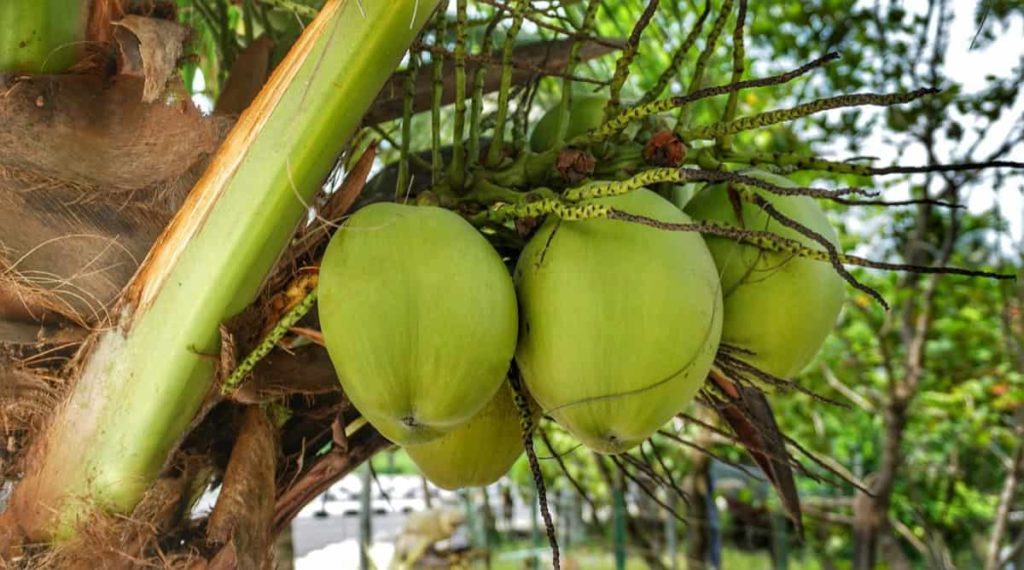
How and when to harvest Coconut
A Coconut palm usually takes 3 or 6 years before the flower starts. Trees can be divided according to the size and height of the palm, and they can be called tall and dwarf. They are also monotonous. Tall trees are about 8 meters long, although some trees may be 20 meters or more. The sowing can be only 2 to 3 meters long when producing fruits.
The tree will also grow about leaves in layers; the old layers fall, while new layers are formed on top to maintain the shape of the umbrella. The time for harvesting Coconut can vary according to the different types and locations of the plant. It also depends on whether you want cold fresh Coconut water or if you want mature white Coconut pulp.
- How to Grow Hibiscus from Flower
- Plantation Ideas for Home Decoration: A Beginners Guide
- Flower Garden Designs and Layouts for Beginners
- Planting and Spacing Techniques in Papaya: A Beginner’s Guide
- Growing Gold: Essential Techniques for Planting Pineapples
- How to Make Kalanchoe Plant Bushy: Home Remedies and Solutions
- 11 Reasons Why Your Gardenia is Not Blooming: Home Remedies and Solutions
- Eco Elegance: The Guide to Designing a Drought-Tolerant Landscape
- Gardening on a Slope: Strategies for Hillside Landscaping
- Nourish and Flourish: Top Organic Mulches for Thriving House Plants
- Everything You Want to Know about Indian Mogra Flower: Discover Uses and Growing
- Green Thumb Success: Expert Tips for Cultivating Greenhouse Pumpkins All Year Round
- Maximize Growth & Flavor: The Ultimate Guide to Companion Planting in Herb Gardens
- How to Control Rhododendron Problems Naturally: Home Remedies and Organic Ways to Fix Them
- Natural Magic: The Remarkable Benefits of Cinnamon for Plants
- Best Steps to Revive Dying Tulip with Natural and Organic Treatment
- 10 Reasons Why Your Angel Trumpet is Not Blooming: Remedies and Treatment
- How to Fix Periwinkle Leaf and Flower-Related Problems: Natural Remedies and Solutions
- How to Fix Zinnias Leaf and Flower Problems: Discover Natural and Home Remedies
- Organic Steps to Induce Lemon Tree Flowers: A Comprehensive Guide
- Bloom Booster: Crafting the Perfect Homemade Bougainvillea Fertilizer
- Optimizing Growth: A Guide to Applying NPK Fertilizer for Potted Plants
- 10 Best Homemade Fertilizers for Rubber Plant: DIY Recipes and Application Method
- How to Boost Female Pumpkin Flowers: Effective Steps for More Flowers and High Yields
- Transform Your Indoor Garden: Top Benefits of Pink Salt for Houseplants
- 10 Best Homemade Fertilizers for Peacock Plants (Calathea): Easy DIY Guide
- Unlock Blooms: 9 Reasons Why Your Potted Chrysanthemum is Not Blooming
- 8 Reasons Why Your Potted Hibiscus is Not Blooming: Fix it with Simple Solutions
- Unlock Blooms: 9 Key Reasons Your Potted Frangipani Won’t Flower
- 10 Reasons Why Is My Ice Plant Not Blooming: Remedies and Treatment
- 10 Reasons Why My Potted Hydrangea Not Blooming: Treatment and Remedies
- 10 Reasons Why is My Wisteria Not Blooming: Remedies and Treatment
- 10 Reasons Why is My Goldfish Plant Not Blooming: Remedies and Treatment
- Maximize Your Space: Ultimate Guide to Balcony Gardening with Grow Bags
- 10 Reasons Why Your Iris is Not Blooming: Remedies and Treatment
- 10 Reasons Why Your Anthurium Plant is Not Blooming: Treatment and Remedies